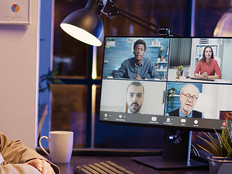Disruptive Change Requires a Mobile Rethink
Resistant to change? Better call for help.
The old saying “adapt or die” rings louder than ever in the digital age. And today’s unforgiving pace of change puts late adopters on shaky ground.
Luckily, there’s a lifeline for businesses embracing mobile technology, tech-savvy workers and cloud-enabled applications.
“Technology moves forward, and it rarely waits for those who don’t choose to adapt,” says Bryan Bassett, a research analyst for mobile enterprise device solutions at IDC.
On a high level, smartphones and tablets upend entire industries, says Bassett, but “the proper application of mobile technology has transformative powers.”
At an organizational level, mobile devices disrupt companies from the inside out. But fear not: This means huge benefits for businesses, including increased communication and productivity, says Bassett.
It also means big — and sometimes uncomfortable — changes to the way a company does business, including new strategies, altered processes and additional investments in infrastructure.
“Even for enterprises with large, mature mobile strategies, it’s difficult to keep up,” he says. “If an enterprise doesn’t have some sort of mobile strategy in place, they’re quite behind. While it may be difficult, it’s going to be necessary to remain competitive going forward.”
Mobility as the Competitive Edge
Percentage of organizations that will have a BYOD program in place by 2020
SOURCE: Newsweaver, “The Workplace App Explosion: Emerging Trends in Internal Communication,” May 2015
At Burns & McDonnell, an engineering, architecture and construction firm based in Kansas City, Mo., mobile devices have contributed to increased worker productivity — especially while traveling — and strengthened the company’s business continuity plans.
“Mobile computing allows for anytime, anywhere computing,” says IT Manager Ed Stufflebean. But, he adds, those devices require the IT shop to make new accommodations and provide additional support.
“It does lead you to enhance and change your infrastructure,” he says, offering security as an example. “Before, you always had your machines inside your network and checking in, getting security updates and application updates. We’ve made improvements to our infrastructure, so if employees are offsite, they’ll still get their updates and security patches when they connect to the Internet.”
In the architecture and engineering fields, mobility means different things relative to the work at hand. Burns & McDonnell equips many of its employees with Microsoft Surface Pro 3 tablets and Lenovo ThinkPad T450 Ultrabooks, but the ThinkPad W541 — a notebook that weighs nearly six pounds and is powerful enough to support computer-aided drafting programs — also plays a central role in the company’s mobile strategy.
Establishing New Mobile-Friendly Workflows
In healthcare, New England Geriatrics had a mobile workforce with no mobile connectivity. The elder-care provider, based in West Springfield, Mass., had long used paper forms to allow its team of traveling clinicians to record interactions with patients at nursing homes, assisted living centers and long-term care facilities.
Clinicians would save their notes for several days, then mail them back to the organization’s headquarters, where it took a week to process. Once the bills were sent out, the company wasn’t paid for another two weeks — resulting in a monthlong gap between the time of service and when the company received payment.
While the term “mobile” applies primarily to smartphones and tablets, for New England Geriatrics, notebooks offer many of the same mobility challenges and opportunities. This past summer, the organization took its first step toward mobility, deploying HP notebooks to its 160 clinicians.
“This has transformed our organization,” says CIO Eric Pavlak. “We’ve gone from all paper to all electronic within the span of a month.”
The company made the change to comply with a federal law requiring healthcare agencies to keep electronic health records. But the move also has helped shorten billing cycles, has saved manpower on back-end processing and — administrators hope — will eventually allow clinicians to provide services more efficiently.
“There’s a tremendous amount of efficiency you gain in the back office by not having to handle the paper,” Pavlak says. “Handling paper is a labor-intensive operation.”

New England Geriatrics CIO Eric Pavlak. Photo credit: Asia Kepka
Delivery Driven by Mobile Devices
Similarly, Relay Foods, a Charlottesville, Va.-based online grocery store, uses iPads and Android tablets to streamline workflows for its sales, warehouse and delivery workers. Sales brings tablets to events to show a demo of the company’s website to potential customers and sign them up for the service.
Relay’s warehouse employees carry the devices with them as they fulfill customer orders, checking products off their screen as they pick out food items. The company’s truck drivers use tablets to track deliveries and find information about customer orders and addresses.
Until a couple of years ago, all of those processes were paper-based.
“We would go through a lot of paper,” says Kyle Savage, a software engineer at Relay Foods. “I’m not sure if it has paid for itself on that side of things or not. But because we’re employing an electronic process, the number of errors we see before orders go out to the customer has gone way down.”
A Plan for Providing Mobile-Device Support
As the pace of technological change increases, IT managers at Burns & McDonnell find their device lifecycle getting shorter. To adapt, the company cut its four-year technology refresh cycle down to three years.
Workers rely on the machines to help present detailed plans to clients, and the company found its older hardware couldn’t keep up with newer software.
On top of that, a number of tablets and notebooks were failing during their fourth year, resulting in costly data retrieval efforts and worker downtime.
“If someone’s machine failed, that could keep them down for a day or more,” says Michael Allen, an IT manager at the firm. “When they’re into year four, and they’re already struggling with a machine that’s not performing the way they would like it to, and then that machine fails, it’s just not a good user experience.”
The constant purchasing of new devices represents just one of many steps businesses must take to support mobility, from ensuring connectivity to managing security. But Allen says the expenditures pay for themselves through increased productivity.
“The time it would take users to wait on their old technology when they could be doing productive work — we were losing those hours,” he says. “We knocked some processes down from 40 minutes to five minutes after the refresh. You’re paying people with doctorates and master’s degrees, and you want them to be productive.”
Burns & McDonnell also changed the way it handles mobile devices to accommodate cloud-based services. Allen says the company would have been slower to adopt cloud, but mobility forced its hand. “It’s that anytime, anywhere mentality,” he says. “If you have to be connected to the corporate network to get access to your files and data, that doesn’t lend itself to mobile.”
Connecting Mobility with Clinics
With the highly sensitive nature of healthcare, security tops concerns. But Pavlak needed to safeguard data in a way that didn’t confuse clinicians — some of whom had never owned a computer. He opted to encrypt notebooks with BitLocker, and also use a clientless VPN.
“It looks at the traffic, and if the traffic is headed back to the office, it puts it in the tunnel,” Pavlak explains. “It doesn’t require any gymnastics on the part of the end user to implement it.”
Sometimes, the need for extra support pops up in the most unexpected places, as Relay Foods’ Savage can attest. For example, the company had to purchase special gloves so that its employees could handle tablets in areas like the warehouse milk cooler.
“One thing we didn’t anticipate is how cold an iPad device gets in a refrigerator,” Savage says. “It was pretty surprising.”








